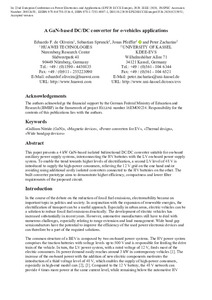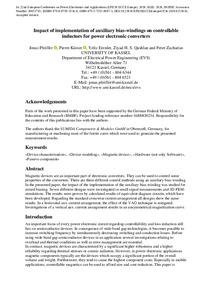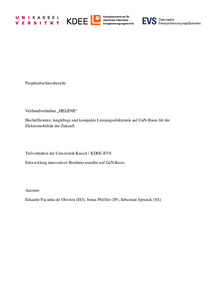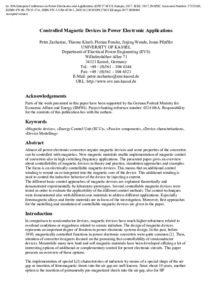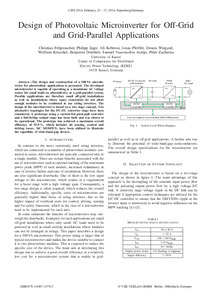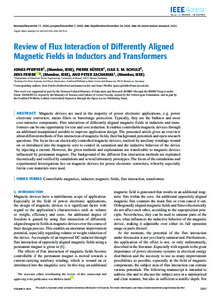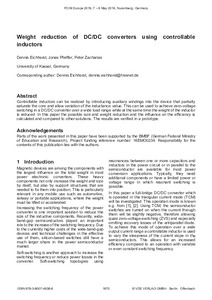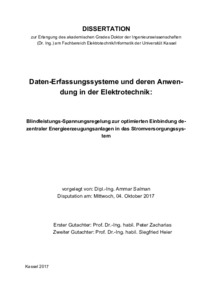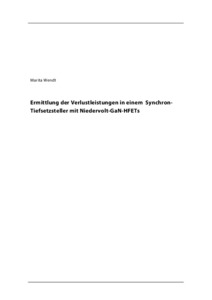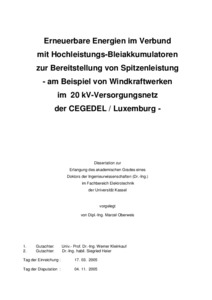Suche
Anzeige der Dokumente 1-10 von 23
Konferenzveröffentlichung
 A GaN-based DC/DC converter for e-vehicles applications
A GaN-based DC/DC converter for e-vehicles applications
(IEEE, 2020)
This paper presents a 4 kW GaN-based galvanically isolated bidirectional DC/DC converter suitable for on-board auxiliary power supply systems, interconnecting the HV battery with the LV power system. To enable the trend towards higher levels of electrification, a second LV level of 48 V is introduced to supply the high-power consumers, relieving the 12 V grid on the one hand and/or avoiding using additional costly isolated converters connected to the HV batteries on the other. The built converter prototypes aim to ...
Konferenzveröffentlichung
 Impact of implementation of auxiliary bias-windings on controllable inductors for power electronic converters
Impact of implementation of auxiliary bias-windings on controllable inductors for power electronic converters
(IEEE, 2020)
Magnetic devices are an important part of electronic converters. They can be used to control some properties of the converters. There are three different control methods using an auxiliary bias-winding. In the presented paper, the impact of the implementation of the auxiliary bias-winding was studied for mixed biasing. Seven different designs were investigated in small signal measurements and 3D-FEM-simulations. The results were proven by calculated results of equivalent diagram circuits, which have been developed. ...
Working paper

 Verbundvorhaben "HELENE" - Hocheffiziente, langlebige und kompakte Leistungselektronik auf GaN-Basis für die Elektromobilität der Zukunft
Verbundvorhaben "HELENE" - Hocheffiziente, langlebige und kompakte Leistungselektronik auf GaN-Basis für die Elektromobilität der Zukunft
(2020)
Die vom Fachgebiet Elektrische Energieversorgungssysteme (EVS) am Kompetenzzentrum für Dezentrale Elektrische Energieversorgungstechnik (KDEE) der Universität Kassel durchgeführten und in diesem Bericht vorgestellten Arbeiten haben einen Beitrag zum Verbundvorhaben „Hocheffiziente, langlebige und kompakte Leistungselektronik auf GaN-Basis für die Elektromobilität der Zukunft“ (HELENE) geleistet. Ziel des Gesamtvorhabens war die Untersuchung der Einsatzfähigkeit und die Bewertung und Demonstration von Gewichts- und ...
Konferenzveröffentlichung
 Controlled magnetic devices in power electronic applications
Controlled magnetic devices in power electronic applications
(IEEE, 2017)
Almost all power electronic converters require magnetic devices and some properties of the converters can be controlled with magnetics. New magnetic materials enable implementation of magnetic control of converters also in high switching frequency applications. The presented paper gives an overview about controllability of magnetic devices in theory and practice, simulation approaches and examples. The focus is on electrically controllable magnetic devices. This means that an additional control winding is wound on ...
Konferenzveröffentlichung
 Design of Photovoltaic Microinverter for Off-Grid and Grid-Parallel Applications
Design of Photovoltaic Microinverter for Off-Grid and Grid-Parallel Applications
(VDE Verlag, 2014)
The design and construction of a 500VA microinverter for photovoltaic applications is presented. The developed microinverter is capable of operating as a standalone AC voltage source for small loads or, alternatively, as a grid-parallel system. Possible applications are therefore small off-grid installations as well as installations where space constraints do not allow enough modules to be combined to use string inverters. The design of the microinverter is based on a two stage concept. Two alternative topologies for ...
Aufsatz

 Review of Flux Interaction of Differently Aligned Magnetic Fields in Inductors and Transformers
Review of Flux Interaction of Differently Aligned Magnetic Fields in Inductors and Transformers
(2020-12-24)
Magnetic devices are used in the majority of power electronic applications, e.g. power electronic converters, mains filters or burst/surge protection. Typically, they are the bulkiest and most cost-intensive components. Flux interaction of differently aligned magnetic fields in inductors and transformers can be one opportunity for size and cost reduction. It enables controllable magnetic devices through an additional manipulated variable to improve application design. The presented article gives an overview about ...
Konferenzveröffentlichung
 Weight reduction of DC/DC converters using controllable inductors
Weight reduction of DC/DC converters using controllable inductors
(VDE Verlag, 2019-07)
Controllable inductors can be realized by introducing auxiliary windings into the device that partially saturate the core and allow variation of the inductance value. This can be used to achieve zero-voltage switching in a DC/DC converter over a wide load range while at the same time the weight of the inductor is reduced. In this paper the possible size and weight reduction and the influence on the efficiency is calculated and compared to other solutions. The results are verified in a prototype.
Dissertation
 Daten-Erfassungssysteme und deren Anwendung in der Elektrotechnik
Daten-Erfassungssysteme und deren Anwendung in der Elektrotechnik
(2018-03-06)
Die vorliegende Arbeit vergleicht unterschiedliche Arten der Blindleistungsbereitstellung durch dezentrale, erneuerbare Energiesysteme.
Dissertation
 Ermittlung der Verlustleistungen in einem Synchron-Tiefsetzsteller mit Niedervolt-GaN-HFETs
Ermittlung der Verlustleistungen in einem Synchron-Tiefsetzsteller mit Niedervolt-GaN-HFETs
(2015-10-29)
Wenn sich in einem wichtigen Bereich der Elektrotechnik ein neues Halbleitermaterial zu etablieren beginnt, weckt dies einerseits Erwartungen der Wirtschaft und Industrie, andererseits kann es eine erhebliche Herausforderung für die Hersteller bedeuten. Nachdem Gallium-Nitrid erstmalig vor 20 Jahren als Transistor verwendet wurde und seit über einer Dekade serienmäßig in der Hochfrequenztechnik eingesetzt wird, erobert es nun die Leistungselektronik. Die ausschlaggebenden Kriterien sind hier die Verwendbarkeit bei ...
Dissertation
 Erneuerbare Energien im Verbund mit Hochleistungs-Bleiakkumulatoren zur Bereitstellung von Spitzenleistung - am Beispiel von Windkraftwerken im 20 kV-Versorgungsnetz der CEGEDEL / Luxemburg -
Erneuerbare Energien im Verbund mit Hochleistungs-Bleiakkumulatoren zur Bereitstellung von Spitzenleistung - am Beispiel von Windkraftwerken im 20 kV-Versorgungsnetz der CEGEDEL / Luxemburg -
(2005-12-05)
Die wachsende Weltbevölkerung bedingt einen höheren Energiebedarf, dies jedoch unter der Beachtung der nachhaltigen Entwicklung. Die derzeitige zentrale Versorgung mit elektrischer Energie wird durch wenige Erzeugungsanlagen auf der Basis von fossilen Primärenergieträgern und Kernenergie bestimmt, die die räumlich verteilten Verbraucher zuverlässig und wirtschaftlich über ein strukturiertes Versorgungssystem beliefert. In den Elektrizitätsversorgungsnetzen sind keine nennenswerten Speicherkapazitäten vorhanden, deshalb ...

